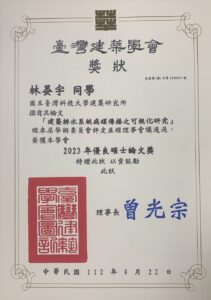【競賽名稱】:2023年建築研究成果發表會
【主辦單位】:臺灣建築學會
【競賽主旨】:
本會為拓展學術發表風氣,建立研究發表制度,在第十屆張世典理事長任內,經由學術委員會及研究發展委員會的努力策劃下,於七十七年十一月舉辦首開建築界的「建築學術研究發表會」。每年發表會由各大專院校建築系輪流負責執行,每屆發表會並彙編出版論文集,現已成為國內建築界一個不可或缺的發表舞台。 本會創辦此項發表會,對促進國內建築學術研究,具有相當重大的意義,經由此種學術性發表活動,吸引有興趣的人士前來參與,可拓展學術活動的接觸面,並希望此發表會活動能和學校科系的教學產生良性的互動關係,加強教學相長的正面影響。
【獲得名次】:2023年優良碩士論文獎
【參賽學生】:林晏宇
【指導教授】:鄭政利教授
【作品名稱】:建築排水系統病媒傳播之可視化研究 【研究摘要】:
Covid-19 於 2019 年末爆發後席捲全球,感染人數上億,死亡人數超過 400 萬人,為消除病毒繼續造成的危害,各國政府與學者紛紛投入疫情的防範中;本研究團隊從建築排水系統的角度切入,討論潛藏的病媒傳染途徑,從案例分析中可以得知破封的排水管路不僅無法阻擋汙染傳遞甚至可能成為病媒傳播的渠道,而本研究透過電腦模擬軟體 COMSOL Multiphysics 的輔助,可視化病媒透過破封管路從患者的居住空間擴散至其他未汙染空間中;本研究設定一常見 12 層電梯社區大樓,透過電腦模擬探討病媒於排水系統中傳播之危險性,以污染氣體的擴散行為代示病媒的傳播,可視化病媒於大樓排水系統中之擴散情形,再篩選出四種環境因子:距離、時間、壓力、初始設定濃度,分別做為操作變因,於軟體中調整其參數再觀察系統的變化,以此為各因子與系統間的關係進行數值化的討論;另外設計一不同的管路配置模擬不同管路配置下的病媒傳播行為,並討論其模擬結果;從模擬結果中得知,病媒確會隨著失效排水系統傳播,且在適當的條件底下,病媒在一小時內就會抵達鄰近的三四樓層中,在三天內將上下層樓化為高風險的感染區,距離、時間、壓力皆是病媒擴散時重要的環境因子,確實的影響傳播情形,而初始設定濃度相較於壓力為較不重大的環境因子,對系統影響較小;透過可視化以圖形方式清楚呈現望能促進政府及國民正視此隱患,共同加入排水系統維護此重大討論中。
【ABSTRACT】:
The outbreak of Covid-19 has been plagueing the world since 2019, during the pandemic, it causes over 200 million infections and 4 million deaths. In order to stop further destruction caused by the virus, government and scholars throw themselves into studies about the pandemic. Our research group starts our article from the prospective of architecture and focuses on a potential infection route – drainage system. Through case study, we knew that dysfunctional drainage system no only couldn’t act as blockage between us and contaminant but also potentially become a virus spreading route. In this article, we conducted several fluid simulations inside pipelines with the help of COMSOL Multiphysics, visualized virus spreading from patient’s room to others’ un-infected residential units through pipelines. In this article, a commonly seen 12 stories building was designed as simulation model, through the help of computer and simulation software, we could visualize the unseen and analyze its hazard. Moreover, we filtered out four environmental factors to be discussed in this article: distance, time span, pressure, initial concentration. By manipulating these factors, we could mathematically discuss the relationship between the factors and the behavior of the contaminant. Besides, a simulation with different pipeline arrangement is also included to observe the virus diffusion behavior under different scenarios. Eventually, with the help of simulation, we concluded that under certain assumption contaminant would reach out through drainage system and arrived neighboring 3 or 4 floors within an hour, and under continuous diffusion, the whole building would be exposed under severe infection risk. Distance, time span, and pressure are considered as critical factors that affect the system greatly, on the other hand, initial concentration doesn’t act as important as the others. Through visualizing the behavior of normally invisible virus, we have a glimpse of what might have been happening behind the wall, and so we hope through this article, we could stimulate the society and the government to have a conversation of the importance of maintaining functional drainage system under health aspect.
